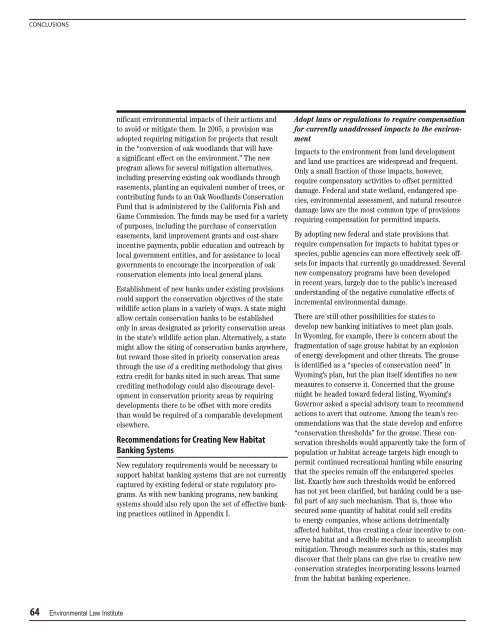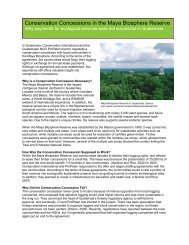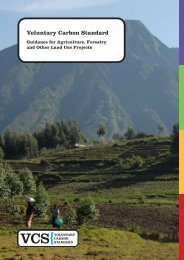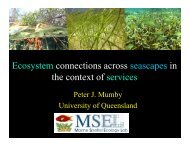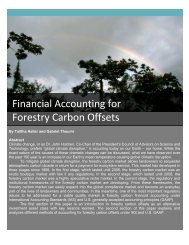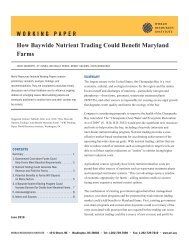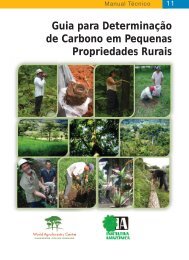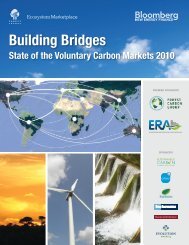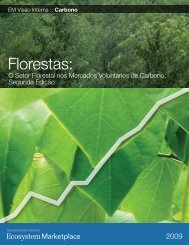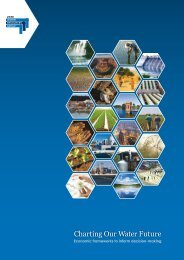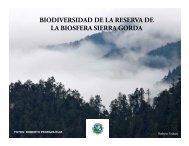CONCL<strong>US</strong>IONSnificant environmental impacts <strong>of</strong> <strong>the</strong>ir actions and<strong>to</strong> avoid or mitigate <strong>the</strong>m. In 2005, a provision wasadopted requiring mitigation for projects that resultin <strong>the</strong> “conversion <strong>of</strong> oak woodlands that will havea significant effect on <strong>the</strong> environment.” The newprogram allows for several mitigation alternatives,including preserving existing oak woodlands througheasements, planting an equivalent number <strong>of</strong> trees, orcontributing funds <strong>to</strong> an Oak Woodlands <strong>Conservation</strong>Fund that is administered by <strong>the</strong> California Fish andGame Commission. The funds may be used for a variety<strong>of</strong> purposes, including <strong>the</strong> purchase <strong>of</strong> conservationeasements, land improvement grants and cost-shareincentive payments, public education and outreach bylocal government entities, and for assistance <strong>to</strong> localgovernments <strong>to</strong> encourage <strong>the</strong> incorporation <strong>of</strong> oakconservation elements in<strong>to</strong> local general plans.Establishment <strong>of</strong> new banks under existing provisionscould support <strong>the</strong> conservation objectives <strong>of</strong> <strong>the</strong> statewildlife action plans in a variety <strong>of</strong> ways. A state mightallow certain conservation banks <strong>to</strong> be establishedonly in areas designated as priority conservation areasin <strong>the</strong> state’s wildlife action plan. Alternatively, a statemight allow <strong>the</strong> siting <strong>of</strong> conservation banks anywhere,but reward those sited in priority conservation areasthrough <strong>the</strong> use <strong>of</strong> a crediting methodology that givesextra credit for banks sited in such areas. That samecrediting methodology could also discourage developmentin conservation priority areas by requiringdevelopments <strong>the</strong>re <strong>to</strong> be <strong>of</strong>fset with more creditsthan would be required <strong>of</strong> a comparable developmentelsewhere.Recommendations for Creating New <strong>Habitat</strong><strong>Banking</strong> <strong>Systems</strong>New regula<strong>to</strong>ry requirements would be necessary <strong>to</strong>support habitat banking systems that are not currentlycaptured by existing federal or state regula<strong>to</strong>ry programs.As with new banking programs, new bankingsystems should also rely upon <strong>the</strong> set <strong>of</strong> effective bankingpractices outlined in Appendix I.Adopt laws or regulations <strong>to</strong> require compensationfor currently unaddressed impacts <strong>to</strong> <strong>the</strong> environmentImpacts <strong>to</strong> <strong>the</strong> environment from land developmentand land use practices are widespread and frequent.Only a small fraction <strong>of</strong> those impacts, however,require compensa<strong>to</strong>ry activities <strong>to</strong> <strong>of</strong>fset permitteddamage. Federal and state wetland, endangered species,environmental assessment, and natural resourcedamage laws are <strong>the</strong> most common type <strong>of</strong> provisionsrequiring compensation for permitted impacts.By adopting new federal and state provisions thatrequire compensation for impacts <strong>to</strong> habitat types orspecies, public agencies can more effectively seek <strong>of</strong>fsetsfor impacts that currently go unaddressed. Severalnew compensa<strong>to</strong>ry programs have been developedin recent years, largely due <strong>to</strong> <strong>the</strong> public’s increasedunderstanding <strong>of</strong> <strong>the</strong> negative cumulative effects <strong>of</strong>incremental environmental damage.There are still o<strong>the</strong>r possibilities for states <strong>to</strong>develop new banking initiatives <strong>to</strong> meet plan goals.In Wyoming, for example, <strong>the</strong>re is concern about <strong>the</strong>fragmentation <strong>of</strong> sage grouse habitat by an explosion<strong>of</strong> energy development and o<strong>the</strong>r threats. The grouseis identified as a “species <strong>of</strong> conservation need” inWyoming’s plan, but <strong>the</strong> plan itself identifies no newmeasures <strong>to</strong> conserve it. Concerned that <strong>the</strong> grousemight be headed <strong>to</strong>ward federal listing, Wyoming’sGovernor asked a special advisory team <strong>to</strong> recommendactions <strong>to</strong> avert that outcome. Among <strong>the</strong> team’s recommendationswas that <strong>the</strong> state develop and enforce“conservation thresholds” for <strong>the</strong> grouse. These conservationthresholds would apparently take <strong>the</strong> form <strong>of</strong>population or habitat acreage targets high enough <strong>to</strong>permit continued recreational hunting while ensuringthat <strong>the</strong> species remain <strong>of</strong>f <strong>the</strong> endangered specieslist. Exactly how such thresholds would be enforcedhas not yet been clarified, but banking could be a usefulpart <strong>of</strong> any such mechanism. That is, those whosecured some quantity <strong>of</strong> habitat could sell credits<strong>to</strong> energy companies, whose actions detrimentallyaffected habitat, thus creating a clear incentive <strong>to</strong> conservehabitat and a flexible mechanism <strong>to</strong> accomplishmitigation. Through measures such as this, states maydiscover that <strong>the</strong>ir plans can give rise <strong>to</strong> creative newconservation strategies incorporating lessons learnedfrom <strong>the</strong> habitat banking experience.64 Environmental Law Institute
CONCL<strong>US</strong>IONSGeneral RecommendationsFuture iterations <strong>of</strong> <strong>the</strong> state wildlife action plans orancillary efforts can more effectively support wildlifeconservation by: (1) providing greater specificity as <strong>to</strong><strong>the</strong> location <strong>of</strong> priority habitats so as <strong>to</strong> increase <strong>the</strong>likelihood that banks will be established <strong>to</strong> conservethose habitats; (2) more fully considering <strong>the</strong> role thatbanking can play as a conservation action; and (3)providing information on habitat res<strong>to</strong>ration opportunities.Provide greater specificity as <strong>to</strong> <strong>the</strong> location <strong>of</strong>priority habitatsThe ability <strong>of</strong> states <strong>to</strong> take advantage <strong>of</strong> many <strong>of</strong> <strong>the</strong>opportunities <strong>to</strong> support <strong>the</strong> conservation <strong>of</strong> priorityhabitats through banking may ultimately depend on<strong>the</strong> specificity <strong>of</strong> state plans. Our review <strong>of</strong> <strong>the</strong> firstgeneration <strong>of</strong> those plans indicated a wide range <strong>of</strong>approaches taken by <strong>the</strong> various states (see Chapter 3,<strong>Habitat</strong> Classification Methods and Their Relationship<strong>to</strong> Wetland and <strong>Conservation</strong> <strong>Banking</strong>). Some actionplans, for example, simply identify important habitattypes, without ranking <strong>the</strong>m relative <strong>to</strong> each o<strong>the</strong>r orfur<strong>the</strong>r prioritizing within a habitat type. O<strong>the</strong>r plansmay rank habitat types, but not prioritize areas withina habitat type. Some plans identify where high priorityhabitats occur, but <strong>of</strong>ten at a very coarse level. Veryfew plans identify priority habitats with <strong>the</strong> precisionthat would provide clear guidance <strong>to</strong> a potentialbanker as <strong>to</strong> what parcels he or she should acquire <strong>to</strong>advance <strong>the</strong> state’s objectives most effectively.There appears <strong>to</strong> have been an understandable reluctanceon <strong>the</strong> part <strong>of</strong> most states <strong>to</strong> be very specificin <strong>the</strong>ir action plans about precisely where priorityhabitats are located. Landowner sensitivities, potentialimpacts on property values, and similar concernsmay have led states <strong>to</strong> articulate <strong>the</strong>ir conservationpriorities in general ra<strong>the</strong>r than specific terms.<strong>Conservation</strong> banking decisions, on <strong>the</strong> o<strong>the</strong>r hand,are <strong>of</strong> necessity quite focused on <strong>the</strong> values and functions<strong>of</strong> particular parcels <strong>of</strong> land, both for purposes<strong>of</strong> evaluating <strong>the</strong> negative environmental impacts <strong>of</strong>development and for evaluating <strong>the</strong> environmentalbenefits <strong>of</strong>fered by a potential bank site.Future generations <strong>of</strong> state wildlife action plans, orancillary efforts undertaken <strong>to</strong> supplement existingplans, may provide <strong>the</strong> more detailed information thatis most useful for banking decisions. Because statewildlife action plans are so new, none <strong>of</strong> <strong>the</strong> conservationbanks established <strong>to</strong> date has been influenced by<strong>the</strong>m. As more states experiment with conservationbanking, however, it would be instructive <strong>to</strong> evaluatehow, if at all, state wildlife action plans have influenced<strong>the</strong> development <strong>of</strong> <strong>the</strong> next generation <strong>of</strong> conservationbanks.More fully consider <strong>the</strong> role that banking can playas a conservation actionOur review <strong>of</strong> <strong>the</strong> 50 state wildlife action plansrevealed that only eleven state plans make any reference<strong>to</strong> habitat banking. In five <strong>of</strong> <strong>the</strong>se states, <strong>the</strong>only reference <strong>to</strong> banking is relegated <strong>to</strong> <strong>the</strong> appendicesand in four states <strong>the</strong> plans make only a singlebrief reference <strong>to</strong> banking. Future iterations <strong>of</strong> <strong>the</strong>plans should more fully explore <strong>the</strong> role that bankingcan play in meeting <strong>the</strong>ir conservation objectives.Provide information on habitat res<strong>to</strong>rationopportunitiesFor <strong>the</strong> state plans <strong>to</strong> effectively direct wetlandmitigation banking, <strong>the</strong>y should identify lands withhigh wetland res<strong>to</strong>ration potential. Virtually all <strong>of</strong> <strong>the</strong>state wildlife action plans – 47 <strong>of</strong> <strong>the</strong> 50 plans or 94percent – identify wetlands as a key habitat type. Inaddition, 37 <strong>of</strong> <strong>the</strong> 50 plans – 74 percent – includemaps that identify wetland habitat. Clearly <strong>the</strong> plansrecognize <strong>the</strong> significance <strong>of</strong> wetland habitat forwildlife conservation.However, in <strong>the</strong>ir current iteration, <strong>the</strong> state wildlifeaction plans present some limitations <strong>to</strong> guidingmitigation banks <strong>to</strong> protect critical wildlife habitatidentified in <strong>the</strong> plans. Most <strong>of</strong> <strong>the</strong> wetland acreagethat is identified in <strong>the</strong> plans is existing, high qualitywetlands that retain much <strong>of</strong> <strong>the</strong>ir functional capacity.Although this is valuable information for wetland habitatacquisition, <strong>the</strong>se highly functional wetlands <strong>of</strong>ferlittle opportunity <strong>to</strong> <strong>the</strong> mitigation banker <strong>to</strong> providefunctional “lift” through wetland res<strong>to</strong>ration. Wetlandmitigation providers more generally seek <strong>to</strong> identifyopportunities <strong>to</strong> res<strong>to</strong>re wetland acres, as <strong>the</strong>se siteswill generate far more wetland credits for banking.<strong>Design</strong> <strong>of</strong> U.S. <strong>Habitat</strong> <strong>Banking</strong> <strong>Systems</strong> <strong>to</strong> <strong>Support</strong> <strong>the</strong> <strong>Conservation</strong> <strong>of</strong> Wildlife <strong>Habitat</strong> and At-Risk Species 65


